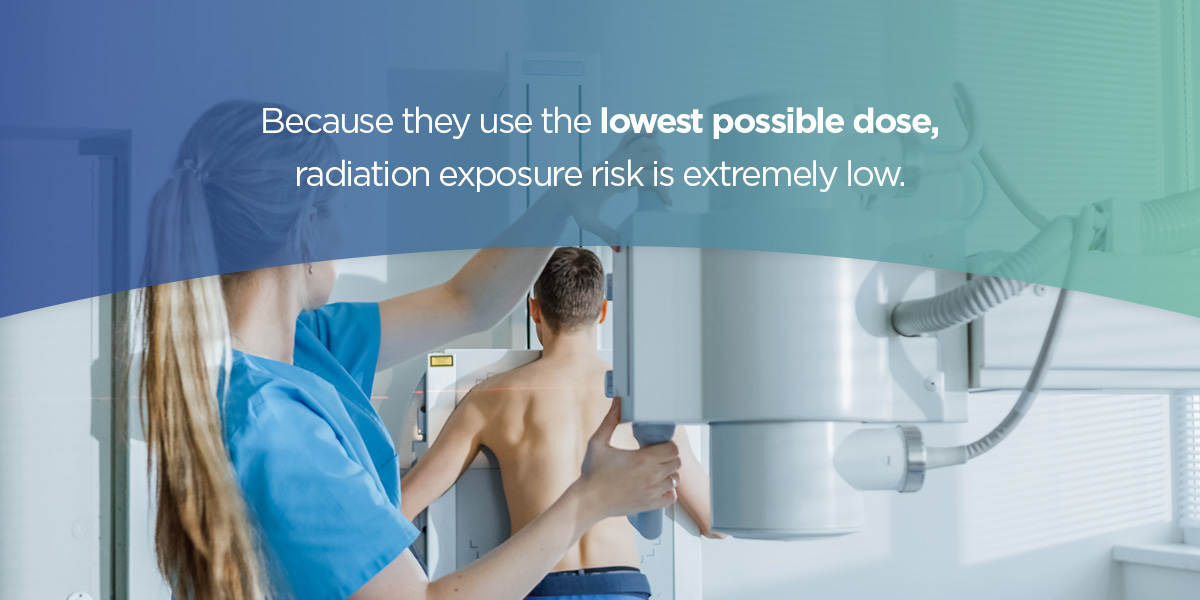How Chest X-rays Help with Asthma Screening and Diagnosis
Asthma is a widely common, long-term condition affecting nearly 25 million people in the U.S. It causes swelling, inflammation and narrowing of the airways, making it difficult to breathe. People with asthma commonly experience coughing, wheezing, and chest pain or tightness.
Several factors including allergens, stress, cold air and exercise can trigger asthma symptoms. While there currently isn’t a cure for this condition, proper diagnosis and treatment can help prevent asthma attacks and improve your quality of life.
Doctors can assess and diagnose people with asthma using many techniques, but chest x-rays are most frequently used when a patient is hospitalized or treated in the emergency room (ER) due to a severe asthma attack. Learn about a chest x-ray’s role in asthma screening and diagnosis and what to expect during the procedure.
How do chest x-rays for asthma work?
An x-ray releases a low dose of electromagnetic radiation through the chest to capture photos of the bones and tissues, including:
- Heart
- Lungs
- Ribs
- Aorta and other blood vessels in the chest
- Muscle and fat
Doctors don’t typically use chest x-rays to directly diagnose asthma but rather to rule out other lung conditions. Several conditions can cause similar symptoms to asthma, such as:
- Bronchitis
- Pneumonia
- Cancerous or noncancerous tumors
- A pneumothorax, or collapsed lung
- Enlarged heart
- Pleural effusion, or fluid between the chest and lungs
- Broken bones
- Something stuck in the airways
If you go to the hospital or ER after a severe asthma attack, you may need a chest x-ray to test for lung damage or other diseases. Additionally, patients suspected of having lung or heart disease will likely require chest x-rays as part of their regular checkups.
People with asthma can benefit from chest x-rays, as they can learn if they have another condition or infection that’s aggravating their breathing difficulties.
What happens during a chest x-ray?
You don’t have to undergo any specific preparation before going in for a chest x-ray appointment. Right before the scan, however, you’ll be asked to change out of your clothes into a hospital gown. You’ll also need to remove any metallic jewelry, watches and other items that can interfere with the x-ray.
During the exam, a technologist will instruct you to sit or stand still in front of the x-ray machine. They’ll either take images from the other side of the wall from the x-ray room or from a separate room. Your technologist will likely take several images with front and side views of the chest.
The exam usually only takes a few minutes. Once the scan is complete, a medical professional will examine the results before passing them along to your physician. You may get the results the same day or the following week, depending on where you get the x-ray done. If any abnormalities are detected, your doctor can suggest further steps and treatment options accordingly.
Are there any risks associated with chest x-rays?
Chest x-rays are generally safe, quick, simple and painless. Because they use the lowest possible dose, radiation exposure risk is extremely low. If you’re pregnant or think you may be pregnant, you should ask your doctor before getting an x-ray. Radiation can potentially affect your baby or increase the risk of birth defects, though the risk is generally small.
Are there other diagnostic tests for asthma?
If your healthcare provider suspects you have severe asthma, they’ll perform additional testing to verify it or determine what else may be causing symptoms. Should they discover you have severe asthma, you’ll need proper treatment and further testing to monitor your symptoms.
There’s a variety of asthma diagnostic tests ranging from digital imaging to standard physical exams. Below are some examples.
1. Blood tests
Blood tests are a routine part of asthma screening. They can identify high levels of white blood cells called eosinophils, lowered vitamin D or iron levels, and immune system function. These tests can also help your doctor determine if any organs are functioning improperly. Detecting one of these health problems can rule out an asthma diagnosis.
2. CT chest scan
A computed tomography (CT) scan is a computerized x-ray procedure that takes detailed images of the inside of your lungs. Medical professionals often use this exam for asthma diagnosis, as it can provide evidence of the condition. It can also rule out asthma by detecting other conditions that mimic its symptoms, like bronchitis, pneumonia or pulmonary fibrosis.
3. Sputum induction test
Sputum is a thick mixture of mucus and saliva in the lungs. As it accumulates, it can cause frequent coughing and breathing difficulty. During a sputum induction test, a specialist takes sputum samples from your lungs. You inhale various concentrations of mildly salty water through a nebulizer, then cough them up. The specialist sends the samples to a laboratory for further testing.
By showing what cells are present, a sputum test can help determine the cause of inflamed airways and the appropriate treatment option to pursue. For instance, high eosinophil levels may suggest eosinophilic asthma.
What asthma treatment options are available?
After an asthma diagnosis, your doctor may recommend medications to help manage your symptoms and address the cause of your condition. Some treatment options include:
- Anti-inflammatory medications: These medications help reduce mucus production and swelling in your airways, making it easier for air to enter and exit the lungs. Your physician may prescribe them to prevent or control chronic asthma symptoms.
- Bronchodilators: Bronchodilators help widen the airways and relax the surrounding muscles. This allows air and mucus to flow more seamlessly through the airways, helping relieve chronic and intermittent asthma symptoms.
- Biologic therapies: These treatments are used for severe asthma cases when symptoms continue despite regular inhaler therapy. Biologic therapies use antibodies created from cells in a laboratory to target specific cells in the body. They’re also called monoclonal antibodies, or mAbs.
There are multiple ways to take asthma medications. You can breathe them in through a nebulizer, metered-dose inhaler or another type of inhaler. Your doctor may also prescribe oral medications like solid or chewable tablets, capsules or syrups.
Request your chest x-ray from Health Images today
Asthma can make everyday activities a challenge, but the appropriate diagnosis and treatment plan makes it easier to manage your symptoms. Consider turning to Health Images if you’re seeking high-quality medical imaging services for asthma diagnosis.
Servicing the Denver area, Boulder and several other locations, we extend the most accurate, up-to-date technology and compassionate care to every patient that visits our facility. Working with highly skilled physicians, we strive to address potential health concerns as quickly as possible. We can even provide same-day results in many cases.
If you need a chest x-ray, our expert team at Health Images can assist you. Request an x-ray appointment today!






